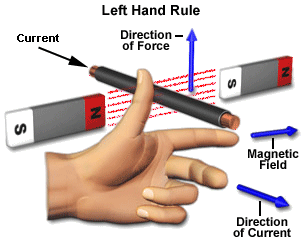
In the above-shown figure, the direction of the magnetic force and magnetic field is given then find out the direction of the particle velocity v.

A) To the right.
B) Downward in the plane of the page
C) Upward in the plane of the page
D) Out of the plane of the page
E) Into the plane of the page.
Answer
218.7k+ views
Hint: For the motion of a charged particle in a magnetic field, the magnetic field vector $B$, the velocity of the particle vector $v$, and the magnetic force vector $F$ that exerted on the particle are all perpendicular to each other.
Complete answer:
The right-hand rule of Fleming states that, to find the direction of the magnetic force on a positive charge, the thumb of the right-hand point in the direction of the velocity of the particle $v$, the fingers in the direction of the magnetic field ($B$), and the force ($F$) is directed perpendicular to the right-hand palm.

The magnetic force on a charged particle with positive charge $q$ moving in a magnetic field $B$ with a velocity $v$ (at angle $\theta $ to $B$) is –
\[\overrightarrow F = qvB\sin \theta \]
\[ \Rightarrow \overrightarrow F = q(\overrightarrow v \times \overrightarrow B )\]
Therefore we can say, force is the cross product of $B$ and $v$ and hence Force is in the perpendicular plane of velocity and magnetic field.
Hence In the figure,

the direction of the magnetic field and force are given. Now if we apply Fleming right-hand rule the direction of the particle velocity will be into the plane of the page.
Hence, the option (E) is the correct answer.
Note: Fleming's rules are applied for determining the relation between the directions of magnetic field, electric current and velocity of a conductor.
There are two rules,
Fleming's left-hand rule for motors which applies for an electric current induces motion in the conductor in the presence of magnetic fields known as Lorentz force.
Fleming's right-hand rule for generators, which applies for a conductor moving through a magnetic field, has an electromotive force induced in it as a result known as Faraday's law of induction.
Complete answer:
The right-hand rule of Fleming states that, to find the direction of the magnetic force on a positive charge, the thumb of the right-hand point in the direction of the velocity of the particle $v$, the fingers in the direction of the magnetic field ($B$), and the force ($F$) is directed perpendicular to the right-hand palm.

The magnetic force on a charged particle with positive charge $q$ moving in a magnetic field $B$ with a velocity $v$ (at angle $\theta $ to $B$) is –
\[\overrightarrow F = qvB\sin \theta \]
\[ \Rightarrow \overrightarrow F = q(\overrightarrow v \times \overrightarrow B )\]
Therefore we can say, force is the cross product of $B$ and $v$ and hence Force is in the perpendicular plane of velocity and magnetic field.
Hence In the figure,

the direction of the magnetic field and force are given. Now if we apply Fleming right-hand rule the direction of the particle velocity will be into the plane of the page.
Hence, the option (E) is the correct answer.
Note: Fleming's rules are applied for determining the relation between the directions of magnetic field, electric current and velocity of a conductor.
There are two rules,
Fleming's left-hand rule for motors which applies for an electric current induces motion in the conductor in the presence of magnetic fields known as Lorentz force.
Fleming's right-hand rule for generators, which applies for a conductor moving through a magnetic field, has an electromotive force induced in it as a result known as Faraday's law of induction.
Recently Updated Pages
A square frame of side 10 cm and a long straight wire class 12 physics JEE_Main

The work done in slowly moving an electron of charge class 12 physics JEE_Main

Two identical charged spheres suspended from a common class 12 physics JEE_Main

According to Bohrs theory the timeaveraged magnetic class 12 physics JEE_Main

ill in the blanks Pure tungsten has A Low resistivity class 12 physics JEE_Main

The value of the resistor RS needed in the DC voltage class 12 physics JEE_Main

Trending doubts
Understanding Collisions: Types and Examples for Students

Understanding Atomic Structure for Beginners

Understanding Centrifugal Force in Physics

JEE Main Marking Scheme 2026- Paper-Wise Marks Distribution and Negative Marking Details

Understanding Electromagnetic Waves and Their Importance

Ideal and Non-Ideal Solutions Explained for Class 12 Chemistry

Other Pages
Understanding Average and RMS Value in Electrical Circuits

Diffraction of Light - Young’s Single Slit Experiment

JEE Main 2025-26 Mock Test: Ultimate Practice Guide for Aspirants

Understanding Excess Pressure Inside a Liquid Drop

Electric field due to uniformly charged sphere class 12 physics JEE_Main

Understanding Elastic Collisions in Two Dimensions




